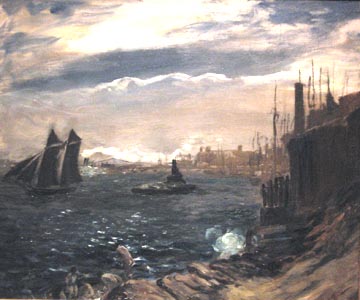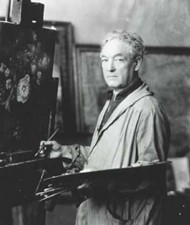
William James Glackens
American, 1870-1938
East River from Brooklyn, 1902
oil on canvas
25 1/8 x 30 in.
SBMA, Gift of Mrs. Sterling Morton for the Preston Morton Collection
1960.57

A youthful self-portrait of the artist William James Glackens, Oil on canvas, Barnes Foundation, Merion, Pennsylvania
"Everything worth while in our art is due to the influence of French art. We have not yet arrived at a national art. The old idea that American art, that a national art, is to become a fact by the reproduction of local subjects, though a few still cling to it, has long since been put in the discard... Our own art is arid and bloodless. It is like nothing so much as dry bones. It shows that we are afraid to be repulsive, afraid to forget restraint, afraid above everything to appear ridiculous..." - William Glackens
RESEARCH PAPER
“William Glackens was one of the most influential American painters in the first decades of the 20th century. From his beginnings as a witty magazine illustrator in Philadelphia and New York to his participation in the forward thinking group of artists dubbed The Eight, Glackens was a perceptive interpreter of his surroundings.”
The Santa Barbara Museum’s painting “East River from Brooklyn” was done in the middle of his life and the middle style of his painting. It measures 25 l/8” by 30” with lots of paint on the canvas. What do we notice first? It is dark and we have to look carefully to see the details of many things that are going on. There is a fairly large sailing vessel on the left, while in the middle a tug boat with white smoke puffing out of its thick stack and when we look hard next to the sailboat we see a white side-wheeler which catches our eye by its high billowing smoke from two smokestacks.
Looking now, back toward shore toward the foreground we see pieces of thick white paint denoting choppy water and at the shoreline the water breaks on rock with a lot of whitewater. On the left in foreground, closest to us (maybe we did not see anything at first because it is so dark) we can make out the shapes of young boys (nick-named river rats) on the rocks or just entering the river. In the distance, about the center of the painting, we see the Brooklyn Bridge stretching across the river in a graceful way. All along the distant shore is the dim skyline of New York. And on the near right side there are old moorings and pier pilings with rough, large pieces of timber. Glackens – the urban realist—did not care to beautify the setting. This is surely just what he saw.
The dark river water is blue mixed with brown and painted in a wet into wet style. However, when we observe the complentary lighter blue color of the sky and and the clouds that have many tints of white, ochre, and grey it is a pleasing combination. The clouds appear to be blown by the wind and they fill up the whole top half of the scene, this seems realistic and natural which is one of Glackens’ goals.
Glackens is a keen observer of a busy scene and he finds way to draw us into it: the three different types of ships, each one on a deliberate course we can only wonder about. The naked youths on the rocks , daredevils who we can also wonder about—they could each have a story.
There is another very similar painting titled” Tugboat and Lighter”, 1904, which also has these three vessels, positioned in a similar manner. However, they have been positioned in another location so we can just make out the shadowy figure of the Statue of Liberty. Glackens frequently places his scene in history for us; sometimes with the clothing styles of the people, sometimes with the mode of travel, and occupations of subjects and at this period in the New York period he shows the seamier side of life. He will include the scenes of smokey skylines, rough dockworkers, and literal garbage on the street. No wonder the group he painted with was called the “Ashcan School”. The Ashcan school of art evolved during the early years of the twentieth century in New York City. The core of the movement was formed by the”Eight” – Robert Henri, Arthur B. Davies, Maurice Prendergast, Ernest Lawson, William Glackens, Everett Shinn, John Sloan, and George Luks – a diverse group of painters opposed to academism who exhibited together in 1908. Another central figure, George Bellows, joined the movement later. Their rebellion against academic art led several to play key roles in organizing the iconoclastic Armory show (1913) and in founding the Society of Independent Artists (1917). The artists focused on urban scenes, particularly those exposing the shabbier aspects of city life. Their intent, however, was not muckraking social commentary but the portrayal of urban vitality.”
Glackens’ two most influential people in his career were Robert Henri and Auguste Renoir. He also had a great friendship with John Sloan ever since he was also a Philadelphia illustrator. Another famous friend was Dr. Alfred Barnes, founder of the Barnes Foundation. However, Glackens was the one suggesting which paintings to purchase on a trip to Paris in 1912. He bought for Barnes many of the impressionists: Van Gogh, Renoir, Pissaro and Cezanne.
While on another trip to Paris with Henri, when they stayed for 15 months, Glackens was enthralled with what he saw and considered Whistler and Manet his ideals. He came back to New York and made many large portraits such as “ Portrait of Chas. Fitzgerald” with the full figure in dark clothing, and solid dark background reminiscent of Whistler.
The last and greatest influence was Auguste Renoir. Glackens moved to France in 1925 to remain until 1932. He lightened his palette and began to separate his paint colors on the canvas. He created rosy cheeked ladies and children, with lavish interior scenes. Glackens even began to be accused of copying Renoir’s style and giving up his own. However, Glackens did return to New York and was elected to the National Academy in 1933, five years before his death.
Prepared for the Docent Council, 2006, Jill T. Harper
Blibliography
Painters Biographies Internet (Barewalls.com)
Snite Museum of Art, University of Notre Dame Internet
Art Cyclopedia, Internet
William Glackens, William H. Gerdts, Abbeville Press, Publishers, New York, 1996
Houghton Mifflin, Online Study Center , Ashcan School

Photo of an older Glackens at his easel
